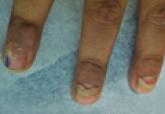Photo Challenge

What Is Your Diagnosis? Onychomadesis Following Hand-foot-and-mouth Disease
A 7-year-old girl presented with new-onset loss of all 10 fingernails and pruritic erythematous papules on the bilateral flanks of 3 weeks’...
Dr. Chiu is from the Department of Dermatology, Pingtung Christian Hospital, Taiwan. Dr. Chiu also is from and Drs. Lan, Wu, and Chen are from the Department of Dermatology, Kaohsiung Medical University Hospital, Taiwan. Drs. Chiu and Lan also are from the Department of Dermatology, Kaohsiung Municipal Ta-Tung Hospital. Drs. Lan and Chen also are from the Department of Dermatology, College of Medicine, Kaohsiung Medical University. Drs. Wu and Wei are from the Department of Dermatology, Kaohsiung Veterans General Hospital. Dr. Kuo is from the Department of Pediatrics, Kaohsiung Chang Gung Memorial Hospital and Chang Gung University College of Medicine.
The authors report no conflict of interest.
Correspondence: Kai-Che Wei, MD, 386 Ta-Chung 1st Rd, Kaohsiung, Taiwan 81362, ROC (kaijhe@gmail.com).

Practice Points
To the Editor:
Onychomadesis is characterized by separation of the nail plate from the matrix due to a temporary arrest in nail matrix activity. Hand-foot-and-mouth disease (HFMD) is a relatively common viral infection, especially in children. Although the relationship between onychomadesis and HFMD has been noted, there are few reports in the literature.1-9 We present 2 cases of onychomadesis following HFMD in Taiwanese siblings.
A 3-year-old girl presented with proximal nail plate detachment from the proximal nail fold on the bilateral great toenails (Figure 1) and a transverse whole-thickness sulcus on the bilateral thumbnails (Figure 2) of several weeks’ duration. Her 6-year-old sister had similar nail changes. Hand-foot-and-mouth disease was diagnosed about 4 weeks prior to nail changes. The mother reported that only the younger sister experienced fever. There was no history of notable medication intake, nail trauma, periungual erythema, vesicular lesion, or dermatitis. In both patients, the nail changes were temporary with spontaneous normal nail plate regrowth several months later. A diagnosis of onychomadesis was made.
The etiology of onychomadesis includes drug ingestion, especially chemotherapy; severe systemic diseases; high fever; infection, including viral illnesses such as influenza, measles, and HFMD; and idiopathic onychomadesis.1,2,5,10 In 2000, Clementz and Mancini1 reported 5 children with nail matrix arrest following HFMD and suggested an epidemic caused by the same virus strain. Bernier et al2 reported another 4 cases and suggested more than one viral strain may have been implicated in the nail matrix arrest. Although these authors list HFMD as one of the causes of onychomadesis,1,2 the number of cases reported was small; however, studies with a larger number of cases and even outbreak have been reported more recently.3-8 Salazar et al3 reported an onychomadesis outbreak associated with HFMD in Valencia, Spain, in 2008 (N=298). This outbreak primarily was caused by coxsackievirus (CV) A10 (49% of cases).5 Another onychomadesis outbreak occurred in Saragossa, Spain, in 2008, and CV B1, B2, and unidentified nonpoliovirus enterovirus were isolated.6 Outbreaks also occurred in Finland in 2008, and the causative agents were identified as CV A6 and A10.7,8 The latency period for onychomadesis following HFMD was 1 to 2 months (mean, 40 days), and the majority of cases occurred in patients younger than 6 years.1-5 Not all of the nails were involved; in one report, each patient shed only 4 nails on average.6

A 7-year-old girl presented with new-onset loss of all 10 fingernails and pruritic erythematous papules on the bilateral flanks of 3 weeks’...
Two Korean men complained of painful erythematous swellings of the proximal nail folds. When we removed the overlying nail plates, we observed new...
